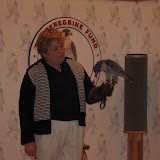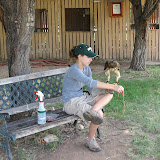- http://www.peregrinefund.org/world_center.asp If you right-click on the picture or caption below, you will see pictures I took at the World Center for Birds of Prey in Boise, Idaho. This seems to be a well-run, well funded facility. Volunteers, most of whom seemed to be retirees, ran the gift shop and gave guided tours through the exhibits. The tour did not include visits to breeding or rehabilitation facilities or the library.
 |
| Raptor Education |
- http://www.rmrp.org/ If you right-click on the picture or caption below, you can see pictures I took at a Rocky Mountain Raptor Program facility in Fort Collins, Colorado. Because of road construction, I was not able to visit the main facility. I was rerouted to another facility by someone who answered the office phone. I arrived shortly after the volunteers. I really enjoyed the casual early morning routine and discussions with the volunteers.
 |
| Raptor Rehabilita |
The World Center for Birds of Prey is very involved in breeding and release to try to prevent extinction and has the backing of the Peregrine Fund for funding research and library facilities. What I saw of the Rocky Mountain program emphasized the rehabilitation and release of injured birds. Both programs are concerned with educating the public about dangers to raptors. As I was leaving the Rocky Mountain facility, a local TV station was preparing to interview the program director about bald eagles being removed from the Endangered Species list.
I learned that raptors live much longer than songbirds-- up to twenty years in the wild, and almost twice as long in captivity. What a tremendous organizational and financial commitment it is for these organizations to maintain the resident birds! Many of the birds that I saw at Rocky Mountain Raptor Program had only been one-to-two years old when first injured. The advantage of rehabilitating and releasing a young bird is that many offspring may be born over the next two decades.
At the Birds of Prey, I heard that birds that are bred in captivity, then released, seem more adaptive to non-traditional habitat and food than birds that have been relocated. Apparently, one of the largest populations for peregrine falcons is now in New York City. These birds seems to have substituted skyscrapers for high cliffs as a habitat.
A few weeks later, I watched a nature show about the red wolves of Ethiopia. These animals live in a small habitat with a limited diet. I wonder if mammals could benefit from a similar breed-release program to new locations...

No comments:
Post a Comment